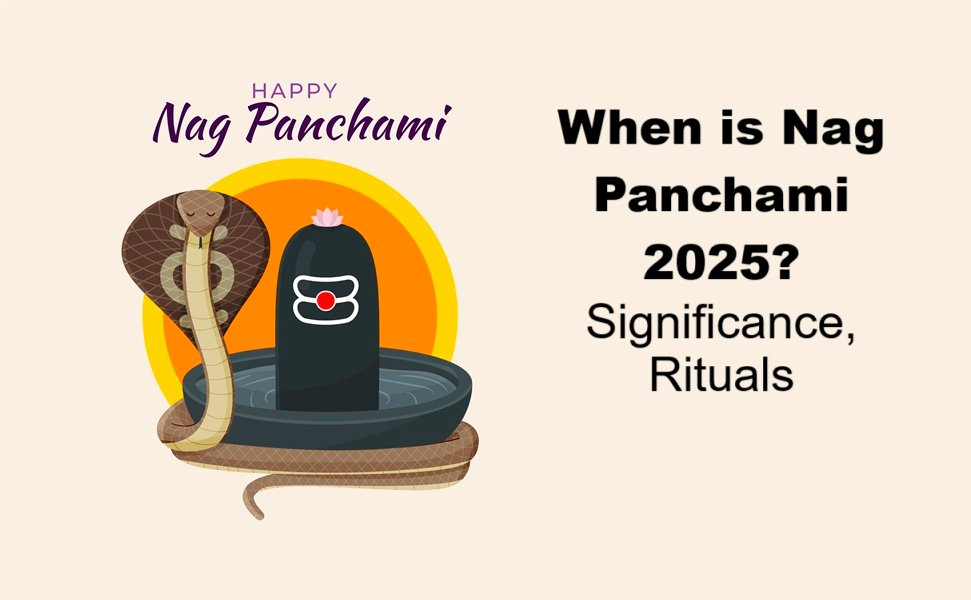
Nag Panchami is a sacred Hindu festival dedicated to the worship of serpent deities, primarily Nag Devtas (snake gods). Celebrated on the fifth day of the Shukla Paksha (waxing moon phase) in the month of Shravan, this festival holds profound spiritual and cultural importance, especially in India and Nepal. It is believed that worshipping Nagas on this day grants protection from snakebites and alleviates the ill effects of Kaal Sarp Dosh in one’s horoscope.
In this comprehensive article, we explore the date, spiritual meaning, traditional customs, do’s and don’ts, powerful mantras, and regional celebrations associated with Nag Panchami 2025.
Nag Panchami
Nag Panchami is rooted in ancient traditions that honor the serpent as a symbol of fertility, rebirth, protection, and the cosmic energy that sustains life. Snakes have held a revered place in Hindu mythology, often appearing in association with major deities like Lord Shiva, Lord Vishnu, and Lord Subramanya.
The festival also serves as a reminder of humanity’s connection to nature and the need to coexist peacefully with all creatures, even those that evoke fear.
When is Nag Panchami 2025?
Nag Panchami 2025 will be celebrated on Tuesday, July 29, 2025.
On this auspicious day, devotees offer milk, turmeric, rice, and flowers to live snakes or idols of Nag Devtas. Temples dedicated to serpent deities witness large gatherings and traditional rituals performed with devotion.
Panchami Tithi Timing:
- Begins: 11:24 PM on July 28, 2025
- Ends: 12:46 AM on July 30, 2025
Nag Panchami Puja Muhurat:
- Best Time for Puja: 05:41 AM to 08:23 AM
(Duration: 2 Hours 43 Minutes)
Note:
In Gujarat, Nag Panchami will be observed on Wednesday, August 13, 2025, due to local calendar customs.
Always refer to a reliable Panchang for exact local timings.
What is the Significance of Nag Panchami?
Nag Panchami carries immense spiritual weight in Hinduism. Here’s why it is so important:
- Mythological Importance:
In Hindu mythology, snakes symbolize protection and immortality. Sheshnag holds the Earth on its hoods, Lord Shiva wears a snake around his neck, and Lord Vishnu rests on Ananta (the endless serpent). - Astrological Belief:
Worshipping Nag Devtas is believed to neutralize Kaal Sarp Dosh, an astrological condition thought to cause hardships and delays in one’s life. - Ecological Symbolism:
Snakes play a vital role in maintaining ecological balance by controlling pest populations. Honoring them fosters respect for nature. - Protection from Snakebites:
Rural communities believe that offerings and prayers on this day provide safety from snake encounters, especially during the monsoon season when snake sightings are frequent.
Rituals and Traditions Followed on Nag Panchami
The way Nag Panchami is celebrated may vary from region to region, but the essence remains universal:
1. Early Morning Bath and Fasting
Devotees wake up before sunrise, take a holy bath, and observe either a partial or complete fast throughout the day.
2. Drawing Snake Images
In states like Maharashtra, Gujarat, and West Bengal, snake images are drawn on the floors and walls using cow dung, turmeric, and natural colors, and worshipped with vermilion, flowers, and incense.
3. Offering Milk and Sweets
Milk, sweets like kheer (rice pudding), jaggery, and ghee are offered to snake idols or live snakes under the supervision of snake charmers.
4. Visiting Snake Temples
Popular snake temples like Mannarasala Temple (Kerala) and Nagoba Temple (Maharashtra) see large congregations where special pujas and rituals are performed.
5. Singing Traditional Songs and Folk Dances
Women perform folk dances and sing traditional songs in praise of Nag Devtas, especially in villages.
6. Kaal Sarp Dosh Nivaran Pujas
Special astrological remedies and pujas are conducted for devotees seeking relief from Kaal Sarp Dosh.
Do’s and Don’ts on Nag Panchami
Respecting the sanctity of the day is important. Here are some traditional guidelines:
Do’s:
- Wake up early, bathe, and pray to Nag Devta.
- Offer milk, turmeric, flowers, and sweets at snake temples or idols.
- Chant specific Nag Panchami mantras for protection and blessings.
- Participate in temple pujas and folk rituals with devotion.
Don’ts:
- Avoid digging the earth or ploughing fields to prevent harming snakes.
- Do not harm, kill, or disturb snakes.
- Refrain from eating salty foods and non-vegetarian dishes on this day.
- Do not show disrespect towards snake icons or any representation of Nag Devtas.
Powerful Mantras and Prayers for Nag Panchami
Chanting mantras on Nag Panchami is considered highly auspicious. It invokes divine protection and removes negativity.
1. Sarpa Shanti Mantra
नित्यम् हरः परायणम् अपहृत्य विषं घोरं करोतु मम शांतिकम्।
अंतरिक्षे ये नागाः ये नागाः स्वर्ग संस्थिताः।
गिरीकन्दर दुर्गेषु ये नागाः भूमिपालयः॥
Meaning:
“May the terrible poison be removed and peace prevail. I worship the serpents residing in the heavens, mountains, caves, and the Earth.”
2. Nag Gayatri Mantra
ॐ नवकुलाय विद्महे विषदंताय धीमहि।
तन्नो सर्पः प्रचोदयात्।।
Meaning:
“Om, we meditate on the lineage of serpents. May the poisonous fanged deity inspire and guide us.”
Tip:
Recite these mantras during the puja muhurat or early morning hours with sincere devotion.
Regional Celebrations and Temple Observances
Nag Panchami is celebrated with unique regional flavors across India and Nepal:
South India
In states like Karnataka and Kerala, devotees worship serpent deities at temples and natural anthills. Temples like the Subramanya Temple witness grand celebrations with special rituals.
Maharashtra
People draw live snake images outside their homes and offer milk and flowers, praying for their family’s protection and prosperity.
Uttar Pradesh and Bihar
Women narrate stories and folk tales related to snake gods and perform community prayers.
Nepal
The festival is celebrated at temples like Pashupatinath, where people make offerings to serpent idols and images drawn at home.
Famous Temples to Visit on Nag Panchami:
- Mannarasala Temple, Kerala
- Nagoba Temple, Maharashtra
- Subramanya Temple, Karnataka
These temples host special rituals, fairs, and cultural programs during the Nag Panchami celebrations.
Conclusion
Nag Panchami is more than a day of worship; it is a celebration of spiritual devotion, ecological respect, and cultural heritage. By honoring Nag Devtas, devotees seek divine protection, astrological relief, and spiritual upliftment.
As Nag Panchami 2025 approaches on July 29, 2025, let us embrace the deep symbolism and age-old traditions of this sacred festival. Offer your prayers with faith, chant the holy mantras, and celebrate the divine serpents as vital guardians of life and cosmic balance.
Wishing you a spiritually enriching and auspicious Nag Panchami 2025!
Image Source: Image by freepik




